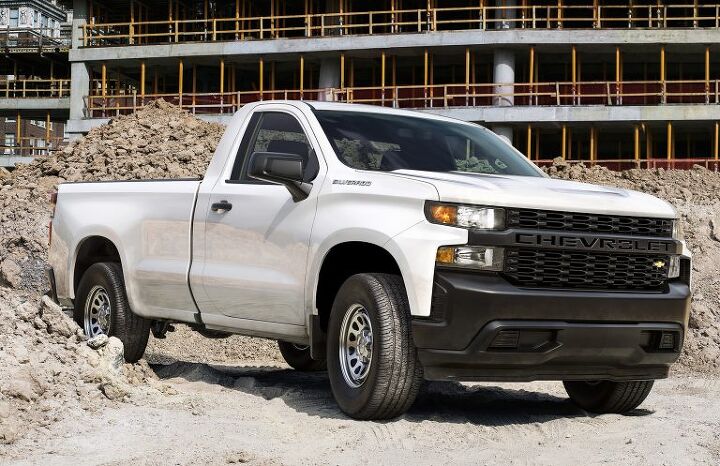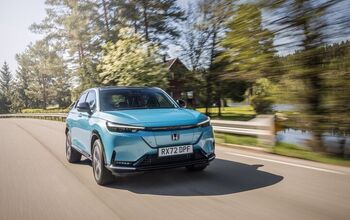Two Fewer Cylinders Spells a Price Drop for Volume 2019 Chevrolet Silverado Trim

Full-size truck buyers looking for the latest thing are spoiled for choice this year. Besides an all-new Ram 1500 (currently unavailable with a V6) and the usual offerings from Ford, there’s a next-generation Chevrolet Silverado and GMC Sierra arriving this fall.
Unlike those other models, the GM twins went somewhere full-size truck builders fear to tread: the land of four-cylinders. Looking at GM’s newly released price list for the 2019 Silverado, it’s clear the new 2.7-liter turbocharged inline-four stands to save buyers money in more ways than one.
You’ll find the 2.7-liter (which GM does everything in its power to avoid calling a four-cylinder) in the high-volume LT trim, as well as the new RST. For 2019, the LT, formerly powered by a standard 4.3-liter V6, drops in price by up to $700. Crew cab models see the maximum drop.
All told, the after-destination price of the LT crew cab is $40, 795. A double cab LT will set you back $38,395 after destination.
With an active fuel management system leaving two of the four cylinders out of the mix under light loads, an eight-speed automatic transmission, grille shutters, and a stop/start system, the 2.7L Silverado stands to leapfrog the previous truck’s fuel economy rating. Of course, we don’t know by just how much. The EPA’s mum on this engine’s thirst, as it is with the upcoming 3.0-liter inline-six diesel.
Power specs for the 2.7L stand at 310 horsepower and 348 lb-ft of torque.
If bare bones hauling is in your future, the base Work Truck drops $400 in price, bringing the after-destination MSRP to $29,795 for the regular cab, long bed model. This model carries a 285-horse 4.3-liter also found in the Custom and Custom Trail Boss 4×4. A familiar 5.3-liter V8 with active fuel management and 355 horses remains an option. All three lesser trims carry a six-speed auto.
As content grows, it’s not surprising to see prices rise accordingly on high-end trims. The LTZ’s entry price grows $700 to $44,495 for a double cab model. A crew cab warrants a $46,895 after-destination sticker. Under the LTZ’s hood, you’ll find a 5.3-liter with Dynamic Fuel Management — a new cylinder deactivation system that offers 17 ways of dropping displacement — mated to an eight-speed auto. EPA estimates show a 1 mpg improvement in the city with this engine, for a rating of 17 mpg city, 23 highway, and 19 combined. These are rear-drive figures.
The same fuel management system appears on the 6.2-liter V8, which comes standard only in the top-tier High Country trim (it’s available for LTZ buyers, along with the 3.0L). For 2019, High Country buyers have to part with an extra $1,000 to get into the truck’s plush confines. Entry price for that trim, only available in crew cab guise, grows to $54,495 after the destination fee.
The 6.2L engine mates to a 10-speed automatic, returning an EPA-estimated 16 mpg city, 20 highway, and 17 combined. As with the LTZ, diesel power remains an option for High Country customers.
[Images: General Motors]

More by Steph Willems
Latest Car Reviews
Read moreLatest Product Reviews
Read moreRecent Comments
- Mikey My youngest girl ( now 48 ) dated a guy that had a Beretta with a stick shift. The Dude liked Beer and weed. too much for my liking..I borrowed my buddy's stick shift Chevette and give her short course on driving a manual .. I told her if the new BF has more than 2 beer or any weed ..You drive ...I don't care how many times you stall it, or or of you smoke the clutch . She caught on quite well ,and owned a succession of stick shift vehicles...An as an added bonus she dumped the guy.
- Blueice "Due to regulation/govt backing, China is poised to dominate BEV/battery production, just as they do solar panel production, drone production, etc.Taiwan dominates production of certain types of chips due to regulation/govt backing and we saw how precarious such a situation is (especially with the PRC increasingly becoming aggressive towards Taiwan).That's why regulation/govt backing is aiming to build up local chip manufacturing."BD2, these businesses and or industries are not free market enterprises, buttcorporatist, bent on destroying their competitors with the use of governmentalunits to create monopolies. How safe are world consumers when the preponderance of computer chipsare made in one jurisdiction. Do you what Red China controlling any industry ??And it is well known, concentrated markets control leads to higher prices to end users.
- Master Baiter I told my wife that rather than buying my 13YO son a car when he turns 16, we'd be better off just having him take Lyft everywhere he needs to go. She laughed off the idea, but between the cost of insurance and an extra vehicle, I'd wager that Lyft would be a cheaper option, and safer for the kid as well.
- Master Baiter Toyota and Honda have sufficient brand equity and manufacturing expertise that they could switch to producing EVs if and when they determine it's necessary based on market realities. If you know how to build cars, then designing one around an EV drive train is trivial for a company the size of Toyota or Honda. By waiting it out, these companies can take advantage of supply chains being developed around batteries and electric motors, while avoiding short term losses like Ford is experiencing. Regarding hybrids, personally I don't do enough city driving to warrant the expense and complexity of a system essentially designed to recover braking energy.
- Urlik You missed the point. The Feds haven’t changed child labor laws so it is still illegal under Federal law. No state has changed their law so that it goes against a Federal child labor hazardous order like working in a slaughter house either.



































Comments
Join the conversation
Ugh, the GM pickups have been hit with Ford's butt-ugly tall-sided Tonka-truck stick. Vomitous.
It was not a smart move to make the Silverdodo into a Toyoduh near clone. This thing looks weak. The Ram looks fine and the Ford is the leader for a reason; I fail to see how this third rate truck will sell better than the old third rate truck it replaces. And if that 4 cylinder actually has sizeable sales, Ford is right there with theirs ready to go that already has worked with the 10 speed transmission or a 6 speed manual.